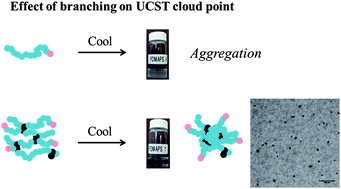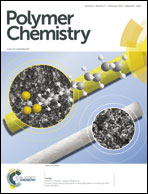One-pot synthesis of responsive sulfobetaine nanoparticles by RAFT polymerisation: the effect of branching on the UCST cloud point†
Abstract
We describe the one-pot synthesis of temperature-responsive branched polymer nanoparticles. Reversible addition–fragmentation chain transfer (RAFT) polymerisation has been utilised to synthesise ultra-high molecular weight sulfobetaine polymers (up to ca. 500 kDa) with good control over molecular weight (Mn) and dispersity (Mw/Mn). The UCST cloud points of these linear polymers were found to increase with both Mn and concentration, and represent one of the few recent descriptions of polymers exhibiting UCST behaviour in aqueous solution. The incorporation of difunctional monomers results in branched polymers which display vastly reduced transition temperatures compared to their linear counterparts. Furthermore, the incorporation of a permanently hydrophilic monomer results in the formation of stable core–shell particles which no longer exhibit a cloud point in water, even at very high concentrations (ca. 50 mg mL−1). The branched polymers are shown to form discrete well-defined nanoparticles in aqueous solution, and these have been characterised by DLS, SLS, TEM and DOSY. Their reversible swelling behaviour in response to temperature is also demonstrated.


 Please wait while we load your content...
Please wait while we load your content...